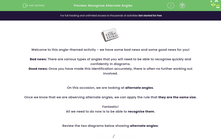
Welcome to this angle-themed activity - we have some bad news and some good news for you!
Bad news: There are various types of angles that you will need to be able to recognise quickly and confidently in diagrams.
Good news: Once you have made this identification accurately, there is often no further working out involved.
On this occasion, we are looking at alternate angles.
Once we know that we are observing alternate angles, we can apply the rule that they are the same size.
Fantastic!
All we need to do now is to be able to recognise them.
Review the two diagrams below showing alternate angles:
.png)
.png)
Here are the key scenarios to observe in relation to alternate angles:
1. They are found within a set of parallel lines. The parallel lines are usually marked with little arrows or dashes.
2. They are found either side of the transversal (i.e. the line cutting through the parallel lines.)
3. They are sometimes called Z angles because they make a Z-shape. (It is best to use their proper name of 'alternate angles' though, as this is how they will be referred to on exam papers.)
4. They are equal in size.
That is all there is to it - we just have to be able to spot them in diagrams now.
Right then, let's put what we know into action.
In this activity, we will learn how to recognise alternate angles and use the key fact, that alternate angles are equal, to find the value of unknown angles and solve related problems.








